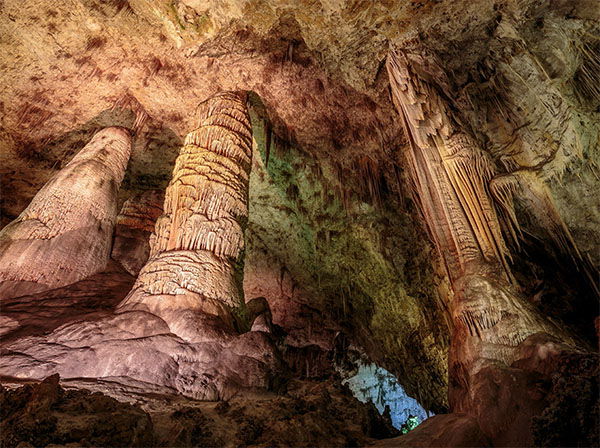Caves—Underground and Upside Down
Revolutionary new thinking has turned the accepted story of cave formation upside down and confirmed the Bible in the process.
The word evokes different responses—fear, fascination, indifference, . . . wonder. These dark retreats are the stuff of legend and monster movies, a den of thieves or hideout of outlaws (not just Jesse James, but troublemakers in the Bible, see Job 30:5–6). Some think of caves as fun side trips on a vacation—and they are. But something else draws cave explorers and scientists: the mysterious origin of these “holes of the earth” (Job’s memorable expression for caves).
All our lives we’ve heard that caves formed slowly, over tens of thousands of years, as surface water seeps into the earth. But recent discoveries are turning old assumptions upside down. The real story may be much more dramatic, as rising acidic waters cut vast caverns in as little as hours.
How different from the traditional story! The old story was based on the slow processes that scientists observe in caves today, and they projected these slow processes into the distant, unobserved past. It never crossed their minds to consider what might happen if God sent a one-time judgment on the earth, during Noah’s day, which created conditions unlike anything we see today.
Such a global catastrophe would unleash unprecedented tectonic forces that would tear apart the earth and stack miles of fresh, water-filled sediments. Water trapped in all those heavy sediments was squeezed out and forced upward. These waters became acidic and dissolved caves as they rose.
The process by which the old way of thinking was transformed—from belief in slow processes to catastrophe—is almost as interesting as the findings themselves. These ideas weren’t formulated in Western Europe or the United States, but in the anti-God, communist Soviet bloc.
Among the leading cave experts who advocate this new view of catastrophic cave formation is a Christian and biblical creationist named Emil Silvestru. But he wasn’t a believer when he first learned about this Bible-affirming view. In fact, he was an atheist working for the world’s first institute for studying caves (located in communist Romania). He learned about catastrophic cave formation there, not in the West.
How God works is truly a riddle wrapped in a mystery inside an enigma.
A Young Discipline
Initially, the study of caves was driven by curiosity, as spelunkers squeezed through thousands of miles of untouched paths under the earth, trying to discern their full extent. It was mostly a Western hobby, performed by amateur explorers and thrill-seekers in the 1800s and early 1900s.
Russia and Eastern Europe, struggling under grinding autocratic oppression, didn’t always have the same freedom to make caving a hobby. Serious study of caves did not take off until the early 1900s, led by enterprising scientists who began exploring the geology of those cave-rich, mountainous regions. The first Institute of Speleology (the study of caves) was founded in Romania—the haunts of Count Dracula—in 1920.
Geologists began reporting some interesting finds, which indicated a few caves may have arisen by hot water rising from deep within the earth. But because of the language barriers and restrictions on information-sharing behind the Iron Curtain, scientists in the West barely heard of these ideas.
A researcher at the forefront of this study was the Ukrainian Alexander Klimchouk. But his work didn’t get the ear of many Western geologists until his visit to the US in 2006–2007, after which he published a book summarizing the startling research so far on this type of cave formation. He called this view hypogene speleogenesis (Latin for “below-the-surface cave-formation”). The traditional view is known as epigenic (“above-the-surface”) speleogenesis.
Now, armed with advanced new tools for studying the earth’s interior, geologists are finding massive new cavities deep in the earth, which have never been exposed to the surface. Indeed, these cavities are widespread, and they exist in many types of rock, not just the limestones traditionally associated with caves.

Cross Cave
Cross Cave is sometimes called “Europe’s most beautiful cave.” With dozens of emerald lakes, it is reputedly the longest cave with underground lakes in the world. In the 1920s, cave experts in Eastern Europe began to consider the revolutionary idea that caves weren’t formed by the same forces we see at work today.
Some caves on our planet are very deep—sometimes hundreds of feet below the present water table. They present a problem for conventional “top-down” views of cave formation. The problem is that no surface water could reasonably flow down this far and continually flow until it removed all the material. So geologists were willing to accept that a few rare cases must involve “bottom-up” processes of rising acidic waters.
Klimchouk, however, made a convincing argument that these sorts of caves are common. And he showed photos and collected papers to support the argument that catastrophic, deep processes have cut caves in many kinds of rocks. The same basic process seems to work no matter what the type of rock.
The evidence seems convincing that catastrophic processes cut these holes from the bottom up.
His book explains why geologists have so often overlooked the clues to this bottom-up explanation. Most caves that were studied are near the surface and are being reshaped by water from above, so this recent influence has obscured evidence of earlier activity from below.
The term cave, after all, technically means an underground cavity that has been “lucky enough” to have enough surface material eroded so that it is exposed to surface invaders. Understandably, this chance access to caves gave us a skewed view of what has really taken place in the holes we can’t see and that haven’t been disturbed by surface water and air.
Klimchouk’s views were earthshaking, but he didn’t go so far as to claim that the vast majority of caves formed this way. That was just too radical. It would take creative thinking by creationists, who are used to turning secular assumptions upside down, to extend these conclusions to cavities worldwide.
A Tale of Two Caves—Carlsbad and Mammoth
Miners have long known that some caves were formed by acidic solutions rising from deep in the earth. Even in ancient times, they would find copper and other valuable ores deposited by these solutions, and they could reach them through these caves. But these types of caves were thought to be rare.
Carlsbad Formed by Sulfuric Acid
A landmark paper in 1987 argued that one of the most famous caves in the world, Carlsbad Caverns, formed rapidly by ascending sulfuric acid. Indeed, the acid could have carved caverns the size of football stadiums in a matter of hours.
If you’ve ever done experiments in a chemistry class, you know how fast lemon juice can eat chalk. Just put a piece of chalk in a dish, pour some juice on top, and see what happens! Sulfuric acid is much more caustic (and dangerous). Although it’s not quite the same, this is a good reminder that unusual conditions, like enormous volumes of acidic water rising through limestone, can do amazing things in a short time.
Geologists in the US are slowly coming on board with this perspective. Emil cites the example of a sign in the Big Room of Carlsbad Caverns, one of the world’s largest cave chambers: “The visitors’ sign originally said the room was at least 260 million years old, but it was changed in 1988 to read 7–10 million years, later 2 million years, and now it’s gone.”

Carlsbad Caverns
In the 1970s, cave experts first suggested that Carlsbad Caverns was dissolved rapidly by sulphuric acid rising from below. How many other caves were formed by similar rapid processes?
Geologists have located the nearby (and lower) sulfur deposits where rising hot water would have flowed through, transformed into sulfuric acid, and then eaten the nearby caverns as it continued to rise (perhaps with the help of bacteria that also love to eat rock).
Emil spent years studying mining caves in Romania, which he believes were formed by rising acidic water. (He referred to it as “hydrothermal” formation, which means it came from rising acidic “hot water.”) Emil’s old report, cited in Klimchouk’s recent book, goes into detail describing the evidence that sulfuric acid from sulfide deposits formed these caves. It even describes stalactites, draperies, and other cave features made of sulfide, not typical limestone.
Emil eventually became a Christian and a creationist. “It became obvious to me that the things I was studying could not come into being by mere chance.” He also realized the profound role of assumptions when interpreting geologic history. If the assumptions about past conditions are wrong, then the conclusions will be wrong too. In a 2003 science paper, published before Klimchouk’s book, Emil argued that his decades of field research had convinced him that all of the earth’s main cave systems were formed by rising waters, not dripping water.
But few secular geologists pay attention to papers presented at creation science conferences.
What About “Standard” Caves Like Mammoth Cave?
Even though Klimchouk and other secular geologists now advocate hypogenic cave formation, they are not willing to go as far as Emil. They still don’t believe that “typical” caves, such as Mammoth Cave in the Cumberland Plateau of southern Kentucky, were formed from catastrophic, bottom-up processes.
The problem is that they often must rely on the work of past geologists who weren’t looking for (or reporting) evidences because they didn’t expect to find them there. The research is complicated by the fact that the newer effects from surface water can often bury or erode the evidence of the earlier bottom-up processes. Those processes occurred deep in the earth before erosion exposed the cavities to the outside world.
Emil has done hands-on research in hundreds of caves, but nobody can visit all the thousands of caves on the planet. Yet everywhere he has looked, the findings are consistent with his claims.
Other creation geologists have come on board to help, doing their own studies in nearby caves. And they’re finding the same thing. One of these active researchers is Kurt Wise, professor at Truett McConnell University. The school is conveniently located in the Cumberland Plateau, where a maze of thousands of caverns weaves through Tennessee and Kentucky.
A geology paper presented at a creation conference in 2009 summarizes what he found at Grassy Cove Saltpeter Cave. It lists fourteen specific kinds of evidences, like those described by Klimchouk, that support the theory that rising hot water cut the cave system.
Even a non-geologist can understand most of these evidences. These underground rivers were flowing upward, so they caused erosion, including “water channels” on the ceiling (see below)!
Creation geologists are only beginning to study caves looking for these features.
But What About All Those Stalactites?
Okay, so the evidence seems convincing that catastrophic processes cut these holes from the bottom up. But what about other famous features inside caves, which we see in travel brochures—those stalactites, columns, and draperies (together called flowstone)?
“Rock of Ages” in Carlsbad, for example, is a column around 30 feet tall. And similar features in other caves rise nearly 100 feet. If they were formed by water dripping from above, surely this took hundreds of thousands of years based on today’s slow rate of buildup (a few centimeters per year, at best, under the wettest conditions).
The global flood changes how we look at the origin of cave features, just as it changes how we look at holes in the earth. Heavy rains started when the fountains of the great deep opened, and this must have been associated with rising magma and massive plate movement. A catastrophe like this would produce the wettest (and warmest) period in earth history. Models indicate that such warm oceans would have generated more heavy rainfall for decades after the flood.
The mineral-rich waters that saturated the planet would have been an ideal breeding ground for cave features, which could have grown at a speed unlike anything we could imagine today.
Creation geologists notice patterns that their secular colleagues miss because they weren’t looking for them.
When creation geologists look at cave features with this biblical catastrophe in mind, they notice patterns that their secular colleagues miss because they didn’t know to look for them.
“In my experience, more than 99% of cave passages lack these speleothem (cave formations like stalactites),” Wise explains. “And in the places where they’re most abundant (near the entrance, which was exposed to the surface only recently), they fill less than 1% of the area. You might get a different impression from commercial caves because they advertise the places most likely to draw visitors.
“It’s easy to explain the limited number of cave formations if they formed from dripping water above after the hole itself was cut by rising acid from below. No flowstone can form while the void is deep in the earth because it would be full of water. Flowstone requires air. So flowstone could begin forming only after the cave appeared and the water drained out. And then it grows only in the rare parts where surface water is flowing from above. This explains why the vast percentage of passages are empty—only a small percentage has been exposed to the air, and it’s only been for a few thousand years.
“In contrast, if the cave formed from seeping surface water, cave features should fill many passages. It takes so long to cut rock with dripping water that you would expect features in nearly all cave passages. So the rarity of flowstone is evidence the caves formed bottom-up and that they are young, not old!”
Right-Side-Up Thinking
The rate of water flow, not time, is the primary factor in the growth of cave features. Just like with cutting the caves, assumptions play a huge role in adding features such as stalactites. If we start in the right place, we’re more likely to end in the right place. With the Bible’s history of the earth as our starting point, we know that caves appeared recently, and these formations developed rapidly.
Given the catastrophic changes introduced by the one-time flood, the existence of vast caves and impressive features is a testament to rapid processes no longer occurring today. Indeed, it turns out that the evidence is forcing even secular scientists, who have no biblical axe to grind, to conclude that rapid processes have been at work.
Truly God’s truth turns the mystery of the enigma of geologic processes—such as caves—upside down.
Carved from the Bottom Up
When you start with the Bible as your foundation, it turns your thinking upside down . . . or more correctly, right side up. That’s what happens with caves.
The conventional story is that caves formed slowly as surface water seeped into the earth. But recent discoveries show that acidic waters, rising from deep in the earth, cut many vast caverns in as little as hours.
Cupolas on the Ceiling
We find domes (cupolas) on cave ceilings that were cut by acidic water pushing up from below.
Recent Entrances
Caves were formed inside the earth, and later erosion exposed some tunnels to the surface. How do we know? The erosion inside cave entrances doesn’t look anything like the erosion on the outside.
Recent Cave Features
Stalactites and other cave features are rare and usually only near the entrance. This shows they formed recently, after the empty cavity was cut. These features also require lots of mineral-rich water, which the global flood supplied in abundance.
Rising Acidic Water
Caves were apparently formed by rising acidic water. Like flowing rivers on the earth’s surface, this water left signs of its power but in different places (like channels on the ceiling!). In some cases, you can still find where the water entered from below, cut horizontally through rock, and then exited at the top.
A Maze of Evidences
Many aspects of caves make sense only if they formed by powerful acidic waters pushing upward under high pressure, not water seeping from the surface. Many caves are part of complex mazes that extend in three dimensions (such as a typical cave system, shown above). The jagged lines and multiple directions point to acids under pressure, pushing through all the weak points.
Later Dripping Water
The beautiful features in caves, such as stalactites, grew as water seeped down from the surface. If this same water carved out the caves, you’d expect these features throughout the cave. But they are rare and usually near the entrance. This indicates these features were formed recently and by a different process than the one that carved the caves.
What could do this? The yearlong flood tore apart the earth and stacked miles of sediment across continents. In the process, acidic waters were trapped in the sediments, then squeezed out and forced upward, carving caves as they rose. We see evidence today on the ceilings—where no one was looking.
All sorts of features show that the caves were originally cut deep in the earth by rising water. Familiar features like stalactites didn’t come until later, when earth movements pushed these cavities near the surface.
So the tiny entrances that we squeeze through today aren’t where the water first went into the cave, but where water came out. How’s that for upside-down thinking!
Related Videos
Dr. Silvestru—Cave Formation and a Young Earth
Answers Magazine
May–June 2018
All our lives we’ve heard that caves form slowly, over tens of thousands of years. But recent discoveries are turning old assumptions upside down.
Browse Issue SubscribeRecommended Resources

Answers in Genesis is an apologetics ministry, dedicated to helping Christians defend their faith and proclaim the good news of Jesus Christ.
- Customer Service 800.778.3390
- © 2024 Answers in Genesis







